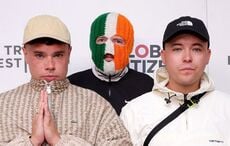"Hunger" is a movie about the last six weeks of Bobby Sands' life. It is directed by Englishman Steve McQueen and stars Michael Fassbender in the lead role. Widely acclaimed, the film has won several awards, the most notable being the 2008 Camera D'Or at the Cannes Film Festival.
Bobby Sands died on May 5, 1981 in the H-Block prison hospital at Long Kesh in Lisburn, County Antrim on the 66th day of his hunger strike. When the prison strike ended on October 3, 1981, nine more men had starved themselves to death.
Inmates had gone on hunger strike in a final attempt to be recognized as political prisoners. The protest began in 1976, when the prisoners refused to wear prison uniforms and went "on the blanket," going naked or wearing blankets. Prison authorities stripped their cells and left them only with chamber pots. After a number of beatings as prisoners left their cells to "slop out," the prisoners began a "dirty protest" in 1978 - covering their walls with excrement and refusing to wash. This continued for two years when the first hunger strike began. That first strike ended in autumn 1980 when the British government seemed to concede the prisoners' demands. However, once the strike was over, the government reverted to its previous stance. The second hunger strike started with Bobby Sands refusing food on March 1, 1981.
The movie covers the blanket protest in blunt and uncompromising detail, leaving nothing to the imagination. The film is over ten minutes old before a word is uttered. The first section deals with the conditions in the prison, followed by the scene between Sands and the priest and culminates with the deterioration and death of Sands from starvation.
For McQueen, a Turner Award-winning artist and first-time feature director with "Hunger," creating the world inside the H-Block was an integral part of the movie. "That was my main research point. I was looking for things in between the word and the history books, the texture, the smell, the environment that one lived in or was subjected to for four and a half years, as well as prison officers having to go into these extraordinary spaces and then have to go home afterwards," McQueen told a round-table discussion for press after a screening for the New York Film Festival in November.
The film portrays a volatile period in the history of Northern Ireland, but McQueen stresses that his focus is on the characters involved. "My films are about people and human beings. Politicians make the situation and then people have to live in it. I am interested in how people deal with it and I leave politics to the politicians."
In the movie, Michael Fassbender, a German-born actor who moved to Killarney when he was two and was brought up in Ireland, took on the responsibility of playing one of the iconic Irish characters of the 20th century. Fassbender's mother is from Larne, County Antrim, so he was no stranger to the North during the Troubles, visiting his mother's family for the summer and school holidays during his youth.
Fassbender had to starve himself to accurately portray the wasting body of Sands as the hunger strike wore on. He went to Los Angeles, found a place on the beach and shed weight with the warmth of the sun on his back. Surviving on nuts, berries and sardines, the six-foot actor went from 160 to 125 pounds over a ten-week period.
During his preparations for the role, the 31-year-old did not meet with the Sands family. In an interview with Ryan Tubridy on RTE, he explained why. "I thought it was a little too close to the bone and I didn't want to bring any emotional blurring into my portrayal of the character."
The weight loss was not the hardest part for Fassbender; instead it was the film's central scene between his character and a priest, played by Liam Cunningham. Seventeen and a half of the 22-minute-plus exchange between the two was shot in one take, believed to be the longest single take in cinema history. After some banter to begin with, the two debate the moral consequences of a hunger strike. For Fassbender this was the pivotal moment for his character.
"The real problem and the real pressure point was that scene. And that was the crux; if that didn't work, then everything could fall apart in the film," Fassbender told Tubridy on the Irish chat show. Cunningham moved in with Fassbender for a week to master the scene. At the screening in New York, McQueen described the process of getting the take right.
"It was about looking at the footage with the actors, discussing and talking with the actors and rehearsing, rehearsing, rehearsing and then more rehearsing, rehearsing, rehearsing. Not letting it take off, just leaving it on the runway, to a point where it wasn't a case of acting or a case of presenting, it was a case of being," said the director. "That is what I wanted; I wanted the acting to be a sphere, you could roll it this way or that way, wherever you roll it, it is a sphere, it is perfect. That is what I wanted it to be."
As Fassbender transformed himself physically for the movie, McQueen's view of actors also completely changed during the process of making "Hunger." "I used to think actors were overbred racehorses, a bit temperamental, a bit too much, actually. But I found out through the process that actors are one of those kinds of people who can translate humanity, and what they have to do in order to do that is quite remarkable."
Exhaustive research was undertaken to get an accurate sense of the environment of that time in Ireland, and producer Robin Gutch told Irish America at the screening about some of the ways that the crew reached out for guidance to portray things accurately.
"One of the sets of people we met were the Bobby Sands Trust, who look after the archive of his images and writings, and they gave us a certain amount of help in fixing up interviews," said Gutch. "They were one of the gatekeepers of getting us into the real research of meeting the [surviving] hunger strikers." Gutch also offered an interesting insight into the writing process of both McQueen and playwright Enda Walsh, who wrote the screenplay. "Both Enda and Steve did a huge amount of research. Enda was the other working mastermind in Northern Irish history from 1980-1982. Enda's method was to completely immerse himself in everything and come up and shake himself off. It was not following any particular line or any particular book or source material."
The movie premiered in Belfast on October 16 and also showed at the London Film Festival. At the London premier Liam Cunningham told The Guardian what they tried to achieve in the movie. "It was an horrendous ordeal that a man went through, and the only thing we could do with the piece was try to be as honorable as we could to what his commitment was. Whether you politically agree with him or disagree, the least we could do was to tell, as much as we could, our interpretation of a truth."
But can one separate the art from the politics? The subject matter of "Hunger" stirs up strong memories on both sides of the political divide in Northern Ireland. In a statement in May, McQueen tried to capture the essence of what he is trying to get across to the viewer: "In 'Hunger' there is no simplistic notion of 'hero' or 'martyr' or 'victim.' My intention is to provoke debate in the audience, to challenge our own morality through film." "Hunger" will be released in the United States in March by the Independent Film Channel.




Comments